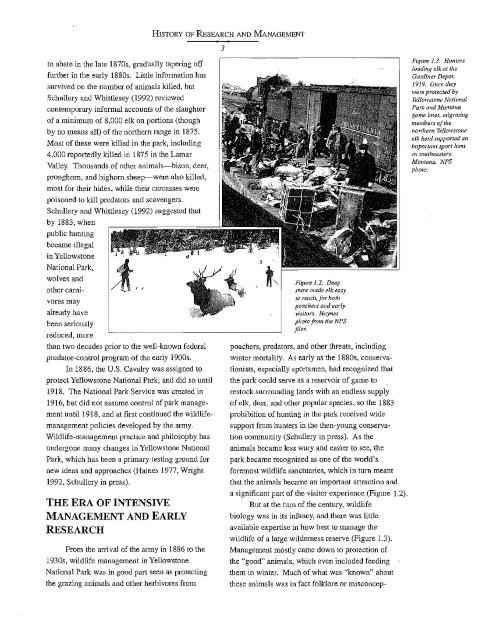Yellowstone's Northern Range - Greater Yellowstone Science ...
Yellowstone's Northern Range - Greater Yellowstone Science ...
Yellowstone's Northern Range - Greater Yellowstone Science ...
You also want an ePaper? Increase the reach of your titles
YUMPU automatically turns print PDFs into web optimized ePapers that Google loves.
HISTORY OF RESEARCH AND MANAGEMENT<br />
3<br />
to abate in the late 1870s, gradually tapering off<br />
further in the early 1880s, Little information has<br />
survived on the number of animals killed, but<br />
Schullery and Whittlesey (1992) reviewed<br />
contemporary informal accounts of the slaughter<br />
of a minimum of 8,000 elk on portions (though<br />
by no means all) of the northern range in 1875.<br />
Most of these were killed in the park, including<br />
4,000 reportedly killed in 1875 in the Lamar<br />
Valley. Thousands of other animals-bison, deer,<br />
pronghorn, and bighorn sheep-were also killed,<br />
most for their hides, while their carcasses were<br />
poisoned to kill predators and scavengers.<br />
Schullery and Whittlesey (1992) suggested that<br />
by 1883, when<br />
public hunting<br />
became illegal<br />
in <strong>Yellowstone</strong><br />
National Park,<br />
wolves and<br />
other carnivores<br />
may<br />
already have<br />
been seriously<br />
reduced, more<br />
than two decades prior to the well-known federal<br />
predator'control program of the early 1900s.<br />
In 1886, the U.S. Cavalry was assigned to<br />
protect <strong>Yellowstone</strong> National Park, and did so until<br />
1918. The National Park Service was created in<br />
1916, but did not assume control of park management<br />
until 1918, and at first continued the wildlifemanagement<br />
policies developed by the army.<br />
Wildlife-management practice and philosophy has<br />
undergone many changes in <strong>Yellowstone</strong> National<br />
Park, which has been a primary testing ground for<br />
new ideas and approaches (Haines 1977, Wright<br />
1992, Schullery in press).<br />
THE ERA OF INTENSIVE<br />
MANAGEMENT AND EARLY<br />
RESEARCH<br />
From the arrival of the army in 1886 to the<br />
1930s, wildlife management in <strong>Yellowstone</strong><br />
National Park was in good part seen as protecting<br />
the grazing animals and other herbivores from<br />
Figure 1.2. Deep<br />
snow made elk easy<br />
to reach, for both<br />
poachers and early<br />
visitors. Haynes<br />
photo from the NPS<br />
flles.<br />
poachers, predators, and other threats, including<br />
winter mortality. As early as the 1880s, conservationists,<br />
especially sportsmen, had recognized that<br />
the park could serve as a reservoir of game to<br />
restock surrounding lands with an endless supply<br />
of elk, deer, and other popular species, so the 1883<br />
prohibition of hunting in the park received wide<br />
support from hunters in the then-young conservation<br />
community (Schullery in press). As the<br />
animals became less wary and easier to see, the<br />
park became recognized as one of the world's<br />
foremost wildlife sanctuaries, which in turn meant<br />
that the animals became an important attraction and<br />
a significant part of the visitor experience (Figure 1.2).<br />
But at the turn of the century, wildlife<br />
biology was in its infancy, and there was little<br />
available expertise in how best to manage the<br />
wildlife of a large wilderness reserve (Figure 1.3).<br />
Management mostly came down to protection of<br />
the "good" animals, which even included feeding<br />
them in winter. Much of what was "known" about<br />
these animals was in fact folklore or misconcep-<br />
Figure 1.3. Hunters<br />
loading elk at the<br />
Gardiner Depot,<br />
1919. Once they<br />
were protected by<br />
<strong>Yellowstone</strong> National<br />
Park and Mofllana<br />
game laws, migrating<br />
members of the<br />
northem <strong>Yellowstone</strong><br />
elk herd supported an<br />
important sport hunt<br />
in SOlltheastem<br />
Montana. NPS<br />
photo.















